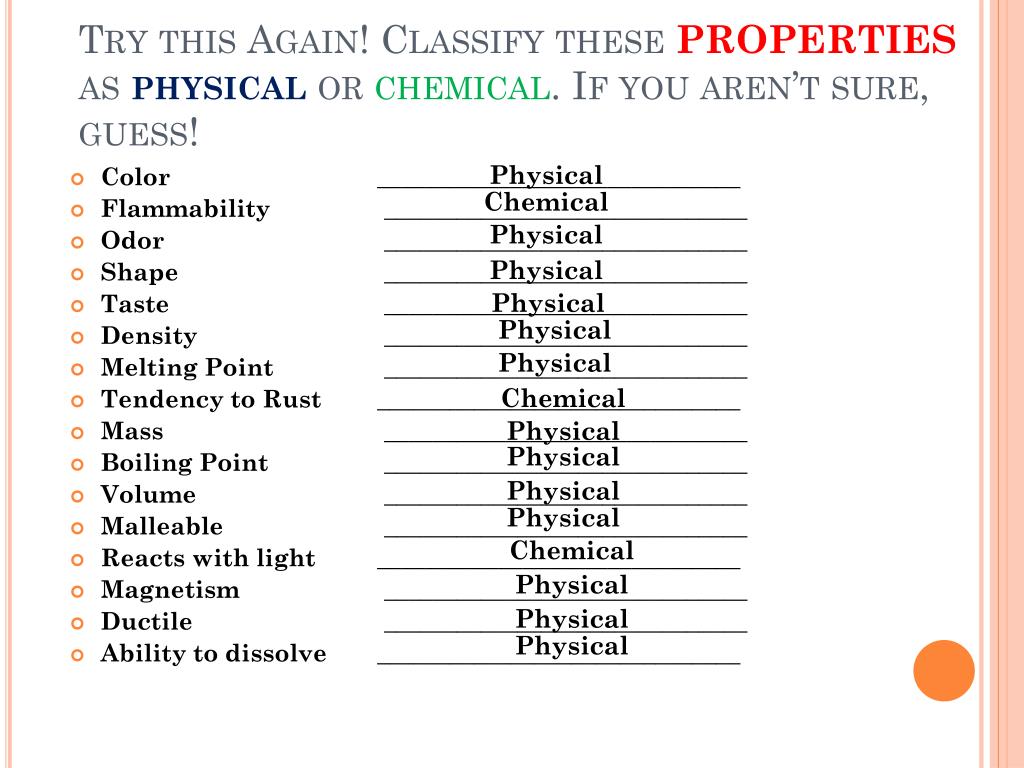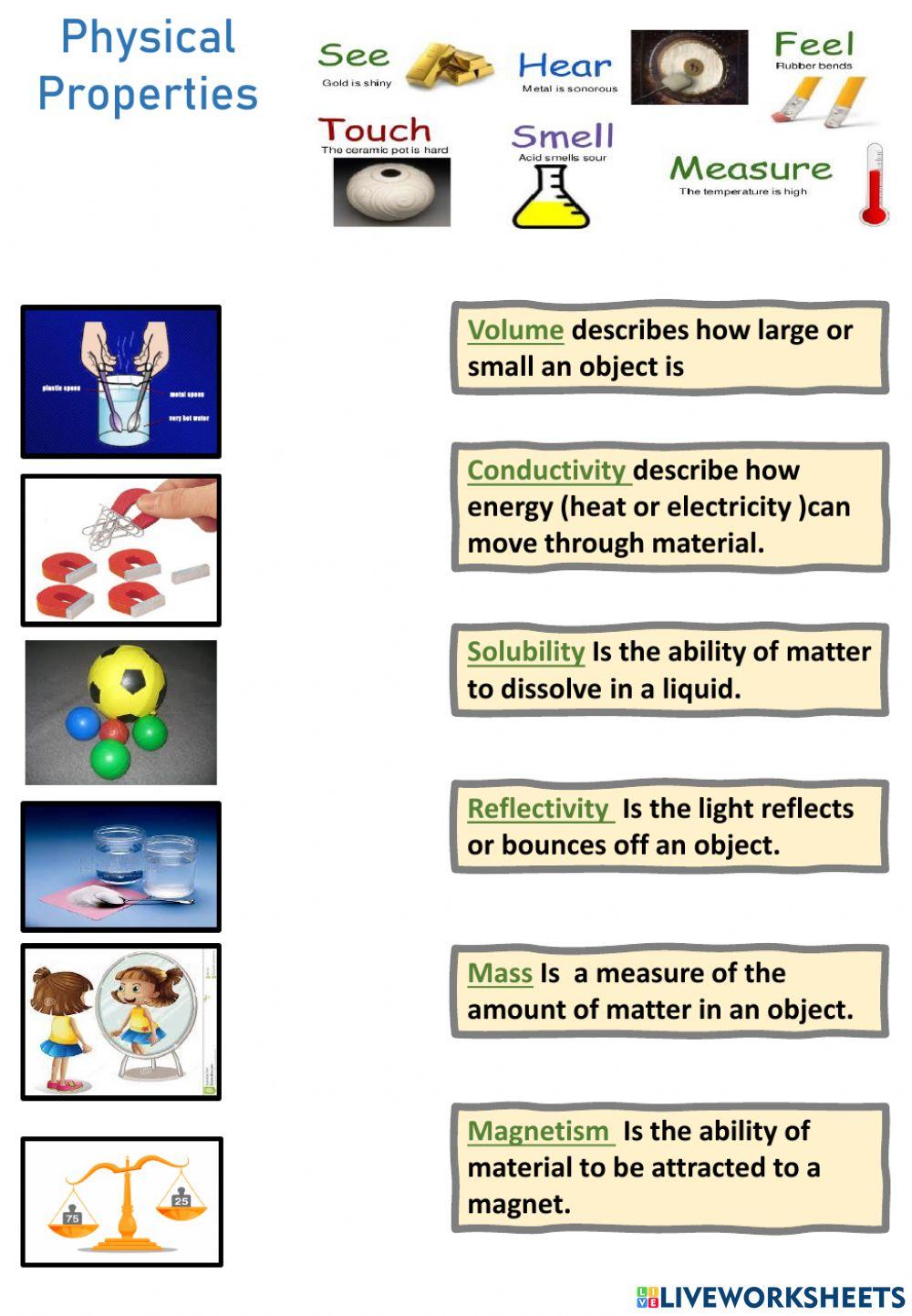A physical property is a characteristic of matter that is not associated with a change in its chemical composition. Familiar examples of physical properties include density, color, hardness, melting and boiling points, and electrical conductivity. We can observe some physical properties, such as density and color, without changing the physical
330 Best Physical Properties of Matter ideas | physical properties of matter, upper elementary science, elementary science
Intensive and Extensive Properties. There are two types of physical properties: intensive properties and extensive properties. Intensive properties: An intensive property is a bulk property, which means that it is a physical property of a system that is independent of system size or material content.Temperature, refractive index, density, and hardness of an object are examples of intensive

Source Image: slideserve.com
Download Image
Density and temperature are intensive, when you combine 2 gallons of water the temperature stays at 20 deg (it does not become 40) and the density stays at approximately 1g/ml. Intensive properties are often constants and can be used to identify a substance. Table 1A.6. 1 1 A .6. 1: Common Physical Properties. Texture.

Source Image: pinterest.com
Download Image
130 Best Properties of Matter ideas | properties of matter, states of matter, science classroom A physical property is any property that is measurable, involved in the physical system, intensity on the object’s state and behavior. The changes in the physical properties of a system can be used to describe its changes between momentary states. A quantifiable physical property is called physical quantity. Measurable physical quantities are often referred to as observables.

Source Image: everydayhealth.com
Download Image
Which Of The Following Is A Physical Property
A physical property is any property that is measurable, involved in the physical system, intensity on the object’s state and behavior. The changes in the physical properties of a system can be used to describe its changes between momentary states. A quantifiable physical property is called physical quantity. Measurable physical quantities are often referred to as observables. Examples of physical properties include mass, density, color, boiling point, temperature, and volume. A physical property is a characteristic of matter that may be observed and measured without changing the chemical identity of a sample.
Overweight but Healthy? The Latest on the Science of ‘Fat but Fit’
A physical property of matter is a characteristic that can be observed and measured without changing the chemical identity of a substance. Any property that can only be observed after a chemical change occurs is a chemical property, but a physical property can be seen when no change occurs or when a physical change happens. Physical and chemical changes in matter anchor chart | Matter science, 8th grade science, Science anchor charts

Source Image: pinterest.com
Download Image
Physical properties exercise | Live Worksheets A physical property of matter is a characteristic that can be observed and measured without changing the chemical identity of a substance. Any property that can only be observed after a chemical change occurs is a chemical property, but a physical property can be seen when no change occurs or when a physical change happens.

Source Image: liveworksheets.com
Download Image
330 Best Physical Properties of Matter ideas | physical properties of matter, upper elementary science, elementary science A physical property is a characteristic of matter that is not associated with a change in its chemical composition. Familiar examples of physical properties include density, color, hardness, melting and boiling points, and electrical conductivity. We can observe some physical properties, such as density and color, without changing the physical

Source Image: pinterest.com
Download Image
130 Best Properties of Matter ideas | properties of matter, states of matter, science classroom Density and temperature are intensive, when you combine 2 gallons of water the temperature stays at 20 deg (it does not become 40) and the density stays at approximately 1g/ml. Intensive properties are often constants and can be used to identify a substance. Table 1A.6. 1 1 A .6. 1: Common Physical Properties. Texture.

Source Image: pinterest.com
Download Image
4,563 Physical Properties Images, Stock Photos, 3D objects, & Vectors | Shutterstock Albedo Area Brittleness Boiling point Capacitance Color Concentration D-F Density Dielectric constant Ductility Distribution Efficacy Electric charge Electrical conductivity electrical impedance Electrical resistivity Electric field Electric potential Emission Flexibility Flow rate Fluidity Frequency I-M Inductance Intrinsic impedance

Source Image: shutterstock.com
Download Image
4,563 Physical Properties Images, Stock Photos, 3D objects, & Vectors | Shutterstock A physical property is any property that is measurable, involved in the physical system, intensity on the object’s state and behavior. The changes in the physical properties of a system can be used to describe its changes between momentary states. A quantifiable physical property is called physical quantity. Measurable physical quantities are often referred to as observables.

Source Image: shutterstock.com
Download Image
Density an object’s mass per unit volume units:. – ppt download Examples of physical properties include mass, density, color, boiling point, temperature, and volume. A physical property is a characteristic of matter that may be observed and measured without changing the chemical identity of a sample.

Source Image: slideplayer.com
Download Image
Physical properties exercise | Live Worksheets
Density an object’s mass per unit volume units:. – ppt download Intensive and Extensive Properties. There are two types of physical properties: intensive properties and extensive properties. Intensive properties: An intensive property is a bulk property, which means that it is a physical property of a system that is independent of system size or material content.Temperature, refractive index, density, and hardness of an object are examples of intensive
130 Best Properties of Matter ideas | properties of matter, states of matter, science classroom 4,563 Physical Properties Images, Stock Photos, 3D objects, & Vectors | Shutterstock Albedo Area Brittleness Boiling point Capacitance Color Concentration D-F Density Dielectric constant Ductility Distribution Efficacy Electric charge Electrical conductivity electrical impedance Electrical resistivity Electric field Electric potential Emission Flexibility Flow rate Fluidity Frequency I-M Inductance Intrinsic impedance